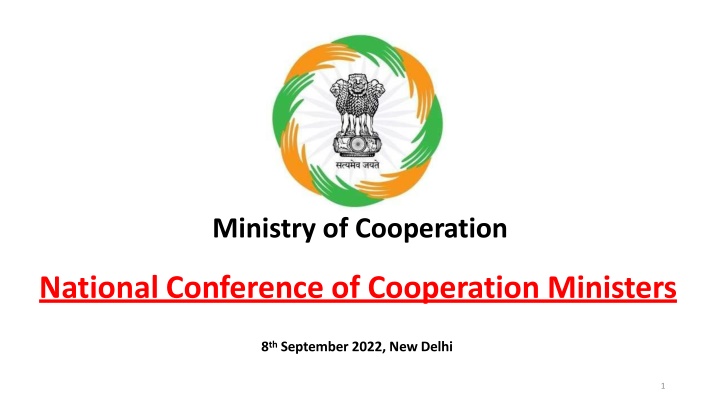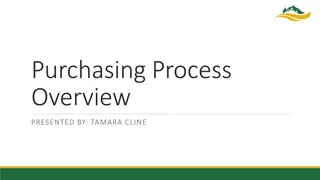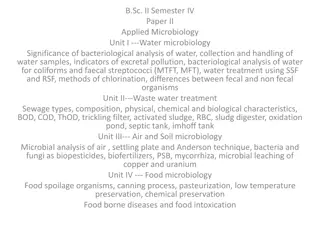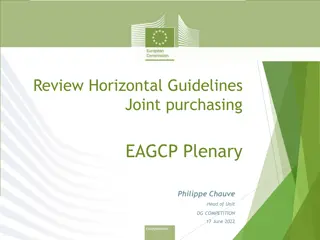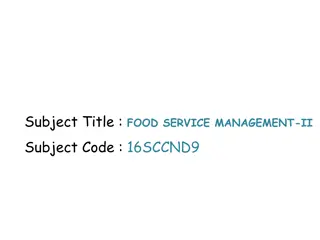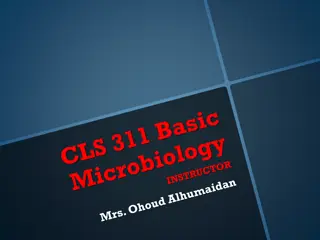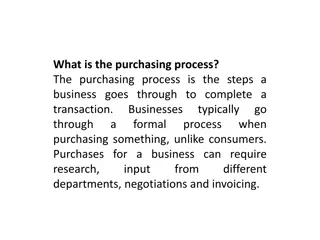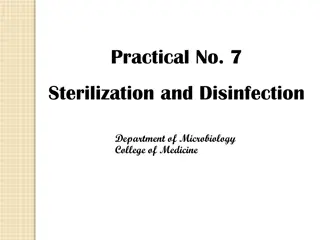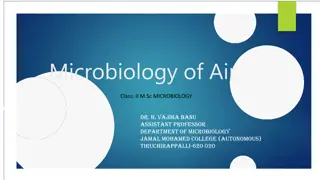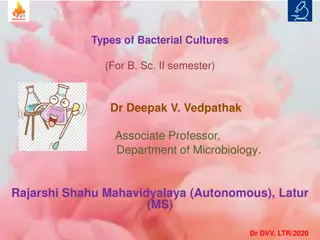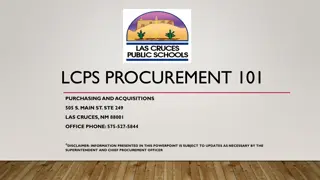Appropriate Purchasing Guidelines for Microbiology Department
Guidelines for procurement processes in the Microbiology Department, including obtaining purchasing approval, using Ben Buys for orders, utilizing federal funding, distinguishing between allowable and unallowable purchases, and managing purchases over $10,000.
Download Presentation

Please find below an Image/Link to download the presentation.
The content on the website is provided AS IS for your information and personal use only. It may not be sold, licensed, or shared on other websites without obtaining consent from the author.If you encounter any issues during the download, it is possible that the publisher has removed the file from their server.
You are allowed to download the files provided on this website for personal or commercial use, subject to the condition that they are used lawfully. All files are the property of their respective owners.
The content on the website is provided AS IS for your information and personal use only. It may not be sold, licensed, or shared on other websites without obtaining consent from the author.
E N D
Presentation Transcript
Ministry of Cooperation National Conference of Cooperation Ministers 8thSeptember 2022, New Delhi 1
VISION New Ministrycreated on 6thJuly,2021. Mission to achieve NationalProsperitythroughCooperatives. StrengtheningCooperatives in the country. ImprovingCooperative Governance. PromotingCooperative-basedEconomic DevelopmentModel. TapEmergingMarkets. Evolving framework for Cooperative Education and Trainingin the country. Creation of policy, legal and institutional framework to help cooperatives realize their true potentialin NationalEconomy. 2
Indian Cooperative Sector at a Glance Totalnumber of cooperatives in different sectors Source: Statistical Profile by NCUI, 2018 No of Cooperative Societies 8,54,355 177605 174319 180000 160000 152351151956 No of Credit Cooperatives 1,77,605 140000 No of non-Credit Cooperatives 6,76,750 120000 100000 Total Cooperative members 29 Cr 80000 60000 46953 o State Cooperative Banks (34) 40000 2990126355236702149317507 1731314932 Branches 2,078 20000 o DCCB(352) 0 Branches 13,610 o PACS 95,509 approx. NABARDAnnual Report2021-22 3
1. Computerization of PACS PACS are the lowest tier of Short-term Cooperative Credit (STCC) structure. 13 Crore Members. PACSfinanced by NABARD through DCCBs and StCBs. All DCCBs and StCBs are already on CBS (Core Banking Solution) provided by RBI. A few States have tried Partial computerization for some activities of PACS. Urgent need to bring all PACS on Multiple Activity based ERP Software being prepared by NABARD. o PACS can use separate modules for various activities (more than 25); o Simplification and Standardization of timely Accounting and Audit through activity linked modules; o As a result, NABARD, StCBs and DCBs can disburse a larger quantum of re-finance to PACS; Process of Computerization for 63,000 functional PACS started - Financial outlay: Rs. 2,516 crores. 4
2. Model Bye-Laws for Multi Dimensional PACS Activities of PACS today are generally limited to Short-Term Credit (STCC) and agricultural inputs. Low Income from Short-Term Credit and agricultural inputs is limiting their true potential for growth. As per NAFSCOB data, around 45% PACS are loss making. Urgent need to provide other profitable activities to PACS and to make them viable and vibrant. More than 25 businessactivities identified for PACS to make them viable and vibrant : o Godown, Procurement of food grains, Manure,Fertilizers, Insecticides, Seeds, Fair Price shop, LPG/Petroletc. o Short and long term credit, Community irrigation, Machinery hiring centre, Processing, Logistics, Refrigeratedvan, etc. Some PACS have old generation Bye Laws. Need modern Bye Laws so as to meet emerging scenario. Model Bye Laws to also improve Governance, Transparencyetc. in line with Cooperative Principles. Consultation with all States/UTs, NABARD, National Federations etc. More than 1500 suggestions received. 5
3. One PACS/Dairy/ Fishery Coop. per Panchayat Number of Districts 757; Number of Panchayats 2,55,493; Number of Villages 6,62,624. No.of PACS 95,509; No. of Dairy Cooperatives 1,90,516; No. of Fishery Cooperatives 23,670. Computerization, adoption of Model Bye Laws and undertaking viable economic activities will enable Modern PACS to function at par with other economic entities and generate surplus. Various Schemes of Central and State/UT Governments can be dovetailed with PACS. Enabling Registration of One PACS/ LAMPS including one primary cooperative society in dairy and fishery sector in every Panchayat/Village. Winding up of defunct PACs to enable registration of new PACS. 6
4. Sahkar-se-Samriddhi Umbrella Scheme Dovetailing Central/ State/ UT Schemes through PACS etc. for setting up viable economic activities S.No InfrastructureFacility CentralScheme (s) 1 Godowns for storage (~2000 MT) AIF (Agriculture Infrastructure Fund), AMI (Agriculture Marketing Infrastructure) 2 Hiring Centre for Agri Equipment SMAM (Sub-Mission on Agriculture Mechanization) 3 Agri-processing Centre PMFME (Pradhan-Mantri Formalisation of Micro Food Processing Enterprises) 4 Cold Storage and Cooling Chambers MIDH (Mission for Integrated Development of Horticulture) 5 Milk chillers, Milk processing facilities DIDF (Dairy Processing and Infra. Development Fund) 6 Fish transport and cold chain network FIDF (Fisheries and Aquaculture Infra. Development Fund) Interest subvention, Grants can be provided under different schemes of Central and States/UT Governments. Loan of more than Rs 1 Lakh Crores can be provided by NABARD and NCDC at reasonable interest rates. 7
5. New National Cooperation Policy Need to replace the Cooperative Policy of 2002. New Policy to realise the vision of Sahakar se Samriddhi . Parity to Cooperatives. National Conference on Cooperation Policy held on 12th-13thApril, 2022. Consultations held with Central Ministries/ Departments, State/ UT Governments, Cooperative Federations/ Unions, Institutions including RBI & NABARD etc. More than 500 suggestions received from concerned stakeholders, including general public. National Level Committee constituted under the Chairmanship of Shri Suresh Prabhakar Prabhu. Committee comprises 47 members from co-operative sector; representatives from National/State/District & Primary Cooperative Societies; Secretaries (Cooperation) & RCSs of States/ UTs; and Officers from Central Ministries/Departments. 8
6. National Cooperative University ToDesign courses needed by the Cooperative Sector in the country at all levels i.e. Primary to Apex and in all Sectors. Tomeet human resource requirements of the existing and new Cooperative Societies in the country. Consolidate the existing 220+ Cooperative Education Centers in the country by providing criteria based affiliation. Provide High end Cooperative MBA Degrees, Diplomas to Lower end Specialisations as required by the cooperation ecosystem. Certificate Courses for existing employees in the Cooperative Sector. Training Courses for the General Body Members, Board of Directors and Employees. Gap analysis and Consultation process with all Stakeholders is at advanced stage. 9
7. National Cooperative Database Need of the Hour - A comprehensive, computerized, interactive, online, dynamic database which will provide single point information for different sectors at different Levels. Consultations held with all stakeholders such as State Governments, Ministries/ Departments, Cooperative Federations, Cooperative Institutions, etc. on various aspects of database such as sector specific fields, availability of data, procedure to collect data, frequency of validation, etc. Sector specific workshops with members from Primary to Apex including experts already conducted in following sectors: o Credit, Dairy, Fisheries, Sugar; o Consumer, Manufacturing, Marketing; and o Labour,Housing. 10
8. New Multi State Cooperative Societies New MultiState Export Cooperative Society National surplus in all sectors can be exported. Farmers can get Global rates for such surplus. Chief Promoters IFFCO, KRIBHCO, NAFED, AMUL and NCDC. New Multi State Seed Cooperative Society Distribution of quality seed to farmers through PACS for increasing agricultural productivity and income. In Collaboration with ICAR, National Seed Corporation, IFFCO, KRIBHCO, NCDC,Agriculture Ministry and State/UT Governments. New MultiState Organic Farming Cooperative Society Promotion, Production and marketing of Organic products at par with international NPOP standards Setting up of testing laboratories, branding of products and sale of products AMUL, NCDC etc. 11
9. National CooperativeDevelopment Corporation Toadvance loans and grant subsidies to State/UT Governments for financing co-operative societies and also direct lending to co-operative societies. NCDC plans to increase disbursement from Rs 34,200 Crore (2021-22) to Rs 60,000 Crore during this financial year.18 Regional Offices to assist all the States/ UTs and Cooperative Societies in the country. Short term credit to expand MSP/ non-MSP procurement, lending to DCCBs and assistance to Women SHG Federations. Timeline: Working Capital Loan in 15 days and Term Loan in 30 days. 1-2% lower rate of interest in the focused schemes like Yuva Sahakar (new cooperatives), Ayushman Sahakar (health sector cooperatives), Nandini Sahakar (women cooperative). Dovetailing with Central Government Scheme like DIDF,PMMSY, FPO Scheme, PMFME etc.
10. Other Initiatives Amendment of the Multi State Cooperative Societies Act, 2002. Computerization of the Office of Central Registrar of Cooperative Societies. Encourage viable Cooperatives for all sections of society including Women and SC/ST. Promote Primary, District and State level Cooperatives in all sectors including Textiles, Self Help Groups etc. Increase marketing opportunities for Cooperatives throughGEM and other similar platforms. Surcharge on Co-operative societies, having total income between Rs 1-10 Cr,reduced from 12% to 7%. Minimum Alternate Tax (MAT) rate reduced for Co-operatives from 18.5% to 15%. Non-scheduled UCBs, SCBs and DCCBs notified as Member Lending Institutions in CGTMSE Scheme. Onboarding of co-operatives as buyer as well as seller on GeM platform. ..
THANK YOU 14
